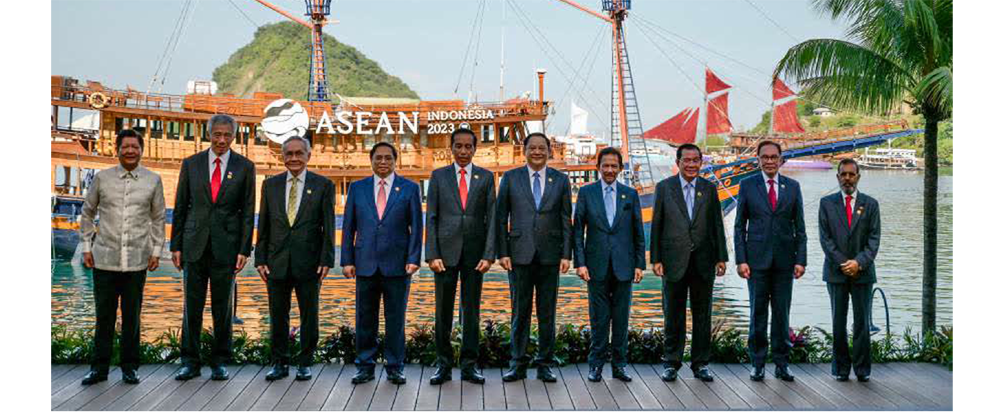Photo: Leaders of ASEAN countries at the 2023 summit
Both the BRICS and ASEAN blocs have indicated their intention to stop using US currency to settle transactions between member states.
by Marco Lopez
BELIZE CITY, Tues. Sept. 12, 2023
One of the looming geopolitical questions is whether the Association of Southeast Asian Nations (ASEAN) will join the BRICS bloc. Both organizations have indicated their intention to make a shift from using US currency in global transactions. The BRICS coalition, made up of Brazil, Russia, India, China, and South Africa, will be joined by six other nations—Iran, Saudi Arabia, Argentina, the United Arab Emirates, Egypt, and Ethiopia—as early as January 2024, expanding the bloc’s membership to 11. The ASEAN bloc comprises 10 Southeast Asian countries: Brunei, Cambodia, Indonesia, Laos, Malaysia, Myanmar, the Philippines, Singapore, Thailand, and Vietnam.
ASEAN is the first regional organization to decide to stop using the US dollar as the primary currency in global trade. In March 2023, the Southeast Asian countries agreed to reinforce the use of local currencies in the region to reduce reliance on major international currencies, according to the Business Standard.
This agreement was reached on the last day of a meeting attended by financial ministers and central bank governors in the region, held in Bali, Indonesia. The Governor of the Bank of Indonesia, Perry Warjiyo, remarked at a virtual press conference following the agreement, “By using local currencies in transactions across the region, we can strengthen our resilience in supporting regional cross-border trade and investment, which currently still rely heavily on major international currencies.”

Similar moves were made at the 15th BRICS summit held in Johannesburg in August of this year. President of Brazil, Luiz Lula, tabled a proposal for the formation of a common currency for trade and investment among BRICS member nations. He remarked that nations that do not use the dollar should not be forced to trade in that currency. Although a BRICS currency was not on the agenda for the South African summit, President of Russia, Vladimir Putin, who attended via videolink, said discussions on shifting trade between member countries away from the dollar to national currencies would take place among members. China did not comment on the matter of a BRICS common currency, but President Xi Jinping promoted the reform of the international financial and monetary system at the summit.
While a common currency for BRICS countries seems an unlikely ideal given the logistical challenges presented by the political and geographic positions of the member countries, there has been a strong push to foster the use of local currencies—a process referred to as de-dollarization.
The 11 members of BRICS and the 10 members of ASEAN are actively moving towards this objective. Indonesia introduced its first de-dollarization task force to promote the use of its Rupiah in bilateral transactions on September 7, 2023.
While all 21 countries in both blocs are harmoniously working towards independence from the US dollar, they have not officially joined forces.
The potential decline of the US dollar as the world’s principal reserve currency marks a seismic shift in the legacy of the Bretton Woods Accords. The post-World War II agreement pegged the US dollar against gold at an exchange rate of $35 per ounce. By 1971, the gold-backed dollar became fiat money as US gold reserves had depleted. This led to the rise of the petrodollar system, brokered by then US Secretary of State, Henry Kissinger during a visit to Saudi Arabia’s King Faisal, establishing a system whereby the Organization of Petroleum Exporting Countries (OPEC) would denominate global oil trade in US dollars.
This system created a synthetic demand for the US dollar, reinforced by a military pact that ensured US support for Saudi Arabia.
In 2021, this system began to falter when Saudi Arabia and the Russian Federation signed a military cooperation agreement, ending the era of the US as the sole protector of the Saudi kingdom. This year, Saudi Arabia’s Minister of Finance, Mohammed Al-Jadaan, announced that the country was open to trading in other currencies in addition to the US dollar. In August, the oil-rich country joined the BRICS alliance, adding momentum to the trend of de-dollarization.
The rise and fall of reserve currencies is historically linked to the fortunes of empires; it is not an uncommon occurrence. From the Dutch with their guilder to the British pound sterling, and now potentially the US with its dollar, the decline of reserve currencies often coincides with the fall of empires. The concerted move away from the dollar by these countries could signal a paradigm shift in the global order.

